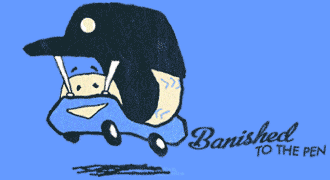Jarrod Saltalamacchia probably cost himself $30 million during the month of October. On a national stage, with the opportunity to make a statement about his potential to be an effective, even star-level catcher just as he was headed for free agency, he fell totally flat, instead. Five weeks after being benched in favor of David Ross for the last few games of the World Series, with no draft-pick compensation attached to him (because the Sox couldn’t justify a qualifying offer to him after his calamitous showing), Saltalamacchia signed a three-year deal worth $21 million, with the Miami Marlins. This deal is interesting on a few levels.
The Spotlight’s Glare
It’s not that Saltalamacchia lacks the mettle or the internal fortitude to succeed in big moments. When he failed during the playoffs, it was because he has a specific, glaring weakness, and the pitchers the Red Sox ran into (especially during the ALCS and World Series) easily exploited it.
Saltalamacchia can’t hit good fastballs, especially ones located up in the zone.
BrooksBaseball.net, which has been one of the Web’s best sources for detailed pitcher and pitch information for years, has really improved the depth and ease of access of their hitter info, lately, too. Their player cards begin by encapsulating a player based on how well he hits various pitches, with summary sentences drawn from a few key numbers. Here’s what the site says of Saltalamacchia, in 2013:
Against All Fastballs (1,144 seen), he has a good eye … and an aggressive approach at the plate … with a disastrously high likelihood to swing and miss (30% whiff/swing).
Only average or better pitchers induce whiffs on 30 percent of swings against their breaking balls. Against fastballs, that number is ghastly. (For a graphic representation of the problem, arching over his entire career, click here.)
Against the Detroit Tigers and St. Louis Cardinals, Saltalamacchia saw a disproportionate number of fastballs whizzing in at 95 miles per hour and more. It’s not terribly fair to fault a catcher for struggling to keep up with that kind of heat, at the end of a long season. It is, however, fair to say that Saltalamacchia needs to be very patient, learn to lay off some fastballs and hit from behind in the count, if he wants to bring his sky-high strikeout rates under control going forward.
The Marlins Effect Doesn’t Exist
It stuns me that, fewer than 400 days after the trade that most clearly marked the cancellation of the Marlins’ experiment with real, live spending, they successfully lured another notable free agent. It’s a reminder that, in more than nine of every 10 cases, players choose the highest bidder in free agency, rather than decide based on other, softer factors. It’s also surprising, though, because the difference between the deal Saltalamacchia accepted and the one he turned down to return to the Red Sox was only $3 million.
Maybe, in that sense, non-monetary factors did drive Saltalamacchia, if he felt wounded after being cast aside at the last moment as Boston complete its title run. Maybe it was because the Marlins guaranteed the third year of this deal, whereas the Red Sox’s offer included an option. In any case, I’m not sure Saltalamacchia couldn’t have made more money by staying in Boston, with the world champions, with better visibility, even at a lower salary. In any case, it sure doesn’t look like players will hold a grudge against the Marlins for their conniving, penny-pinching ways.
How Long Can Saltalamacchia Catch?
Thanks to that slow bat and the dangerous whiff rates that come with it, Saltalamacchia needs to be a catcher in order to have value. Happily, he;’s young yet, and hasn’t had major health issues since 2010. Catchers age badly after 30 or so, but they peak late, and this contract only carries Saltalamacchia through his age-31 season. Still, we need to evaluate his defense a bit in order to decide whether he’s an asset or not.
One of the chief impacts a catcher can have on the game is as a pitch receiver, framing fringe pitches and earning his pitcher some strikes that aren’t, really. Because the wonders of technology never cease, we have a pretty good handle, these days, on which guys are good at this, and which aren’t. Unfortunately, according to the Catcher Framing Reports on StatCorner.com, Saltalamacchia had a below-average year in that regard in 2013. In 2012, though, he was above average, and in 2011, he was very good. Typically, this skill doesn’t age that way, so the best estimate of his true talent for stealing strikes is probably just to the good side of zero. That’s solid.
Less than solid is his throwing arm, the more well-known and visible way that a catcher’s defense matters. He’s thrown out just 79 would-be base-stealers since 2011, against 252 successful swipes. That’s ugly.
In general, it seems like Saltalamacchia can at least stick behind the plate, preserving the positional value of his bat. His pitching staff will just need to make the most of his framing skills, because when they do put people on base, runners will be on second quite often.
The Competitive Horizon for Miami
From a team perspective, this deal is an interesting signal about the Marlins’ confidence that they will return to relevance quickly. As much anger as it generated when they unloaded so many players throughout 2012, the result is a very quickly turned-over roster, a rebuild on the scale of the Houston Astros or Chicago Cubs, but seemingly, faster than either. Giancarlo Stanton and Jose Fernandez are superstars. Adeiny Hechevarria is a stellar defensive shortstop. The Marlins have a trio of promising outfielders just getting established, in Christian Yelich, Jake Marisnick and Marcell Ozuna, and a trio of strong pitching prospects. They’re not ready to throw haymakers with the Nationals or Braves just yet, but they may already be the third-best team in the division, after this signing, and there’s a lot of upside in a team this young. The coming season should be an interesting one for the Fish.
Next post: Dexter Fowler Stands in for the Shin-Soo Choo the Houston Astros Could Never Have HadPrevious post: Jacoby Ellsbury and New York Yankees Make a Great Celebrity Couple




Leave a Reply